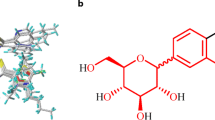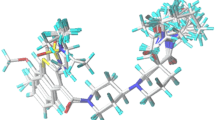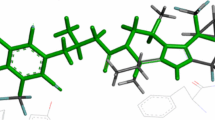Abstract
hURAT1 (human urate transporter 1) is a successful target for hyperuricemia. Recently, the modification work on hURAT1 inhibitors showed that the flexible linkers would benefit biological activity. The study aimed to investigate the contribution of the linkers and give modification strategies on this kind of structures based on QSAR models (HQSAR and topomer CoMFA). The most effective HQSAR and topomer CoMFA models were generated by applying the training set containing 63 compounds, with the cross-validated q2 values of 0.869/0.818 and the non-cross-validated correlation coefficients r2 of 0.951/0.978, respectively. The Y-randomization test was applied to ensure the robustness of the models. The external predictive correlation coefficient (r 2pred ) grounded on the external test set (21 compounds) of two models was 0.910 and 0.907, respectively. In addition, the models were validated by Golbraikh–Tropsha and Roy methods, as well as other statistical metrics. The results showed that both models were reliable. Topomer CoMFA steric/electrostatic contours and HQSAR atomic contribution maps illustrated the structural features which governed their inhibitory potency. The dependable results could provide important insights to guide the designing of more potential hURAT1 inhibitors.
Graphical abstract






Similar content being viewed by others
References
Terkeltaub R (2010) Update on gout: new therapeutic strategies and options. Nat Rev Rheumatol 6(1):30–38. https://doi.org/10.1038/nrrheum.2009.236
Richette P, Doherty M, Pascual E, Barskova V, Becce F, Castaneda-Sanabria J, Coyfish M, Guillo S, Jansen TL, Janssens H, Liote F, Mallen C, Nuki G, Perez-Ruiz F, Pimentao J, Punzi L, Pywell T, So A, Tausche AK, Uhlig T, Zavada J, Zhang W, Tubach F, Bardin T (2017) 2016 updated EULAR evidence-based recommendations for the management of gout. Ann Rheum Dis 76(1):29–42. https://doi.org/10.1136/annrheumdis-2016-209707
Maesaka JK, Fishbane S (1998) Regulation of renal urate excretion: a critical review. Am J Kidney Dis 32(6):917–933. https://doi.org/10.1016/S0272-6386(98)70067-8
Anzai N, Jutabha P, Endou H (2010) Renal solute transporters and their relevance to serum urate disorder. Curr Hypertens Rev 6(3):148–154. https://doi.org/10.2174/157340210791936732
Enomoto A, Kimura H, Chairoungdua A et al (2002) Molecular identification of a renal urate anion exchanger that regulates blood urate levels. Nature 417(6887):447–452. https://doi.org/10.1038/nature742
Vazquez-Mellado J, Jimenez-Vaca AL, Cuevas-Covarrubias S et al (2007) Molecular analysis of the SLC22A12 (URAT1) gene in patients with primary gout. Rheumatology (Oxford) 46(2):215–219. https://doi.org/10.1093/rheumatology/kel205
Reginato AM, Mount D, Yang I et al (2012) The genetics of hyperuricaemia and gout. Nat Rev Rheumatol 8(10):610–621. https://doi.org/10.1038/nrrheum.2012.144
Cai W, Liu W, Liu C, Wang J, Zhao G (2017) A systematic review of uric acid transporter 1 (URAT1) inhibitors for the treatment of hyperuricemia and gout and an insight into the structure-activity relationship (SAR). Chin J Struct Chem 36(6):897–910. https://doi.org/10.14102/j.cnki.02545861.2011-1596
Kong LD, Pan Y (2016) Urate transporter URAT1 inhibitors: a patent review (2012–2015). Expert Opin Ther Pat 26(10):1. https://doi.org/10.1080/13543776.2016.1213243
Wempe MF, Quade B, Jutabha P, Iwen T, Frick M, Rice PJ, Wakui S, Endou H (2011) Human uric acid transporter 1 (hURAT1): an inhibitor structure-activity relationship (SAR) study. Nucleosides, Nucleotides Nucleic Acids 30(12):1312–1323. https://doi.org/10.1080/15257770.2011.594031
Wempe MF, Lightner JW, Miller B, Iwen TJ, Rice PJ, Wakui S, Anzai N, Jutabha P, Endou H (2012) Potent human uric acid transporter 1 inhibitors: in vitro and in vivo metabolism and pharmacokinetic studies. Drug Des Dev Ther 6:323–339. https://doi.org/10.2147/DDDT.S35805
Peng J, Hu Q, Gu C, Liu B, Jin F, Yuan J, Feng J, Zhang L, Lan J, Dong Q (2016) Discovery of potent and orally bioavailable inhibitors of Human Uric Acid Transporter 1 (hURAT1) and binding mode prediction using homology model. Bioorg Med Chem Lett 26(2):277–282
Yong T, Xie Y, Chen S, Chen D, Su J, Jiao C, Hu H, Xiao C (2018) Hypouricemic effect of Grifola frondosa on hyperuricemic mice and virtual screening of bioactives by 3D QSAR pharmacophore modeling. J Funct Foods 40:582–588. https://doi.org/10.1016/j.jff.2017.11.049
Cai W, Wu J, Liu W, Xie Y, Liu Y, Zhang S, Xu W, Tang L, Wang J, Zhao G (2018) Systematic structure-activity relationship (SAR) exploration of diarylmethane backbone and discovery of a highly potent novel uric acid transporter 1 (URAT1) inhibitor. Molecules 23(2):252. https://doi.org/10.3390/molecules23020252
Zhang X, Wu J, Liu W, Liu Y, Xie Y, Shang Q, Zhou Z, Xu W, Tang L, Wang J, Zhao G (2017) Discovery of flexible naphthyltriazolylmethane-based thioacetic acids as highly active uric acid transporter 1 (URAT1) inhibitors for the treatment of hyperuricemia of gout. Med Chem 13(3):260–281. https://doi.org/10.2174/1573406412666160915163002
Tian H, Liu W, Zhou Z, Shang Q, Liu Y, Xie Y, Liu C, Xu W, Tang L, Wang J, Zhao G (2016) Discovery of a flexible triazolylbutanoic acid as a highly potent uric acid transporter 1 (URAT1) inhibitor. Molecules 21(11):1543. https://doi.org/10.3390/molecules21111543
Ahn SO, Ohtomo S, Kiyokawa J, Nakagawa T, Yamane M, Lee KJ, Kim KH, Kim BH, Tanaka J, Kawabe Y, Horiba N (2016) Stronger uricosuric effects of the novel selective URAT1 inhibitor UR-1102 lowered plasma urate in tufted capuchin monkeys to a greater extent than benzbromarone. J Pharmacol Exp Ther 357(1):157–166. https://doi.org/10.1124/jpet.115.231647
Dearden JC (2016) The history and development of quantitative structure-activity relationships (QSARs). Int J Quant Struct-Prop Relationsh 1:1–44
Roy K, Kar S, Das RN (2015) Understanding the basics of QSAR for applications in pharmaceutical sciences and risk assessment. Academic Press, London. https://doi.org/10.1016/B978-0-12-801505-6.00016-8
Yang X-L, Zhou Y, Liu X-L (2013) Hologram quantitative structure–activity relationship studies on 1-(5-carboxyindol-1-yl) propan-2-one inhibitors of human cytosolic phospholipase A2α. Med Chem Res 23(3):1512–1518. https://doi.org/10.1007/s00044-013-0763-5
Maltarollo VG, Honorio K, Emery FS, Ganesan A, Trossini GH (2015) Hologram quantitative structure-activity relationship and comparative molecular interaction field analysis of aminothiazole and thiazolesulfonamide as reversible LSD-1 inhibitors. Future Med Chem 7(11):1381–1394. https://doi.org/10.4155/fmc.15.68
Salum LB, Andricopulo AD (2009) Fragment-based QSAR: perspectives in drug design. Mol Divers 13(3):277–285. https://doi.org/10.1007/s11030-009-9112-5
Babu S, Rupa M, Nagarajan SK, Sohn H, Madhavan T (2016) Molecular modeling study on diazine indole acetic acid derivatives for CRTH2 inhibitory activity. Comb Chem High Throughput Screen 19(6):444–460. https://doi.org/10.2174/1386207319666160502123759
Cramer R, Patterson D, Bunce J (1988) Comparative molecular field analysis (CoMFA). 1. Effect of shape on binding of steroids to carrier proteins. J Am Chem Soc 110(18):5959–5967. https://doi.org/10.1002/chin.198851058
Cramer RD (2012) R-group template CoMFA combines benefits of “ad hoc” and topomer alignments using 3D-QSAR for lead optimization. J Comput Aided Mol Des 26(7):805–819. https://doi.org/10.1007/s10822-012-9583-9
Liang T, Yan C, Yang L, Hu M, Ban S, Li Q (2014) 3D-QSAR studies of 8-substituted chromen-4-one-2-carboxylic acid derivatives as potent agonists for the orphan G protein-coupled receptor 35. Med Chem Res 24(5):2183–2194. https://doi.org/10.1007/s00044-014-1287-3
Araujo SC, Maltarollo VG, Honorio KM (2013) Computational studies of TGF-betaRI (ALK-5) inhibitors: analysis of the binding interactions between ligand-receptor using 2D and 3D techniques. Eur J Pharm Sci 49(4):542–549. https://doi.org/10.1016/j.ejps.2013.05.015
Wempe MF, Jutabha P, Quade B, Iwen TJ, Frick MM, Ross IR, Rice PJ, Anzai N, Endou H (2011) Developing potent human uric acid transporter 1 (hURAT1) inhibitors. J Med Chem 54(8):2701–2713. https://doi.org/10.1021/jm1015022
Sato Pharmaceutical Co, Ltd. US8987473 (2015)
Clark M, Cramer RD, Opdenbosch NV (1989) Validation of the general purpose tripos 5.2 force field. Comput Chem 10(8):982–1012. https://doi.org/10.1002/jcc.540100804
William P-P, Judith AS (1967) A brief review and table of semiempirical parameters used in the Hueckel molecular orbital method. J Chem Eng 12:235–246. https://doi.org/10.1021/je60033a020
Zaheer UH, Sajda A, Abdullah AM et al (2016) 3D-QSAR studies on barbituric acid derivatives as urease inhibitors and the effect of charges on the quality of a model. Int J Mol Sci 17(5):657. https://doi.org/10.3390/ijms17050657
Huang D, Liu Y, Shi B, Li Y, Wang G, Liang G (2013) Comprehensive 3D-QSAR and binding mode of BACE-1 inhibitors using R-group search and molecular docking. J Mol Graph Model 45(18):65–83. https://doi.org/10.1016/j.jmgm.2013.08.003
Flower DR (1998) On the properties of bit string-based measures of chemical similarity. J Chem Inf Comput Sci 38(3):379–386. https://doi.org/10.1021/ci970437z
Ferreira LG, Andricopulo AD (2013) Inhibitors of Trypanosoma brucei trypanothione reductase: comparative molecular field analysis modeling and structural basis for selective inhibition. Future Med Chem 5(15):1753–1762. https://doi.org/10.4155/fmc.13.140
Cramer RD, Cruz P, Stahl G et al (2009) Virtual screening for R-groups, including predicted pIC50 contributions, within large structural databases, using topomer CoMFA. J Chem Inf Model 40(15):2180–2195. https://doi.org/10.1021/ci8001556
Laskowski RA, MacArthur MW, Moss DS, Thorton JM (1993) PROCHECK: a program to check the stereochemical quality of protein structures. J Appl Crystallogr 26(2):283–291. https://doi.org/10.1107/S0021889892009944
Wiederstein M, Sippl M (2007) ProSA-web: interactive web service for the recognition of errors in three-dimensional structures of proteins. Nucleic Acids Res 35:407–410. https://doi.org/10.1093/nar/gkm290
Wold S, Sjöström M, Eriksson L (2002) Partial least squares projections to latent structures (PLS) in chemistry. Wiley, London. https://doi.org/10.1002/0470845015.cpa012
Mitra I, Saha A, Roy K (2010) Exploring quantitative structure–activity relationship studies of antioxidant phenolic compounds obtained from traditional Chinese medicinal plants. Mol Simul 36(13):1067–1079. https://doi.org/10.1080/08927022.2010.503326
Golbraikh A, Tropsha A (2002) Beware of q2! J Mol Graph Model 20(4):269–276. https://doi.org/10.1016/S1093-3263(01)00123-1
Ojha PK, Mitra I, Das RN, Roy K (2011) Further exploring rm2 metrics for validation of QSPR models. Chemometr Intell Lab Syst 107(1):194–205. https://doi.org/10.1016/j.chemolab.2011.03.011
Roy K, Kar S (2014) The rm2 metrics and regression through origin approach: reliable and useful validation tools for predictive QSAR models (Commentary on ‘Is regression through origin useful in external validation of QSAR models?’). Eur J Pharm Sci 62:111–114. https://doi.org/10.1016/j.ejps.2014.05.019
SchC Ebert RU, Chen J, Wang B (2008) External validation and prediction employing the predictive squared correlation coefficient test set activity mean versus training set activity mean. J Chem Inf Model 48(11):2140–2145. https://doi.org/10.1021/ci800253u
Chirico N, Gramatica P (2011) Real external predictivity of QSAR models: how to evaluate it? Comparison of different validation criteria and proposal of using the concordance correlation coefficient. J Chem Inf Model 51(9):2320–2335. https://doi.org/10.1021/ci200211n
Roy K, Das RN, Ambure P, Aher RB (2016) Be aware of error measures. Further studies on validation of predictive QSAR models. Chemom Intell Lab Syst 152:18–33. https://doi.org/10.1016/j.chemolab.2016.01.008
Wu T, Chen J, Dong S, Li H, Cao Y, Tian Y, Fu W, Zhou P, Xi B, Pang J (2017) Identification and characterization of a potent and selective inhibitor of human urate transporter 1. Pharmacol Rep 69(5):1103–1112. https://doi.org/10.1016/j.pharep.2017.04.022
Wang H, Feng Y, Wang Q (2016) Cysteine-based protein adduction by epoxide-derived metabolite(s) of benzbromarone. Chem Res Toxicol 29(12):2145–2152. https://doi.org/10.1021/acs.chemrestox.6b00275
Jiangsu Atom Bioscience and Pharmaceutical Co., Ltd. W0 2017/041732 A1
Fan C, Chen H, Li C (2017) Synthesis of naphthyl triazole carboxylic acid compounds and their inhibitory activities against URAT1. Drugs Clinic 32:1165–1170. https://doi.org/10.7501/j.issn.1674-5515.2017.07.001
Xia C, Wei S, Li S, Wang S (2015) Design, synthesis and biological activity of a novel uric acid transporter 1(URAT1)inhibitor. Chem Reag 37(11):969–975. https://doi.org/10.13822/j.cnki.hxsj.2015.11.003
Acknowledgements
This work was supported by the Natural Science Foundation of China (No: 81773794), Natural Science Foundation of Guangdong Province (2018A0303130088) and the Foundation of science and technology of Guangdong (2014A020210013), China.
Author information
Authors and Affiliations
Corresponding author
Ethics declarations
Conflict of interest
The authors affirm that there are no conflicts of interest.
Additional information
Publisher’s Note
Springer Nature remains neutral with regard to jurisdictional claims in published maps and institutional affiliations.
Electronic supplementary material
Below is the link to the electronic supplementary material.
Rights and permissions
About this article
Cite this article
Zhao, T., Zhao, Z., Lu, F. et al. Two- and three-dimensional QSAR studies on hURAT1 inhibitors with flexible linkers: topomer CoMFA and HQSAR. Mol Divers 24, 141–154 (2020). https://doi.org/10.1007/s11030-019-09936-5
Received:
Accepted:
Published:
Issue Date:
DOI: https://doi.org/10.1007/s11030-019-09936-5




